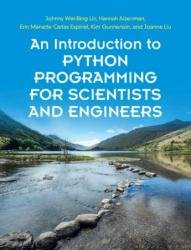 Название: An Introduction to Python Programming for Scientists and Engineers
Название: An Introduction to Python Programming for Scientists and EngineersАвтор: Johnny Wei-Bing Lin, Hannah Aizenman, Erin M.C. Espinel, Kim Gunnerson
Издательство: Cambridge University Press
Год: 2022
Страниц: 766
Язык: английский
Формат: pdf (true)
Размер: 57.7 MB
Python is one of the most popular programming languages, widely used for data analysis and modelling, and is fast becoming the leading choice for scientists and engineers. Unlike other textbooks introducing Python, typically organised by language syntax, this book uses many examples from across Biology, Chemistry, Physics, Earth science, and Engineering to teach and motivate students in science and engineering. The text is organised by the tasks and workflows students undertake day-to-day, helping them see the connections between programming tools and their disciplines. The pace of study is carefully developed for complete beginners, and a spiral pedagogy is used so concepts are introduced across multiple chapters, allowing readers to engage with topics more than once. “Try This!” exercises and online Jupyter notebooks encourage students to test their new knowledge, and further develop their programming skills. Online solutions are available for instructors, alongside discipline-specific homework problems across the sciences and engineering.
Most introductory programming textbooks are written with the assumption that the student thinks like a computer scientist. That is, writers assume that the student best learns programming by focusing on the structure and syntax of programming languages. The result is an introductory textbook that teaches programming in a way that is accessible to future programmers and developers but not as much to scientists or engineers who mainly want to investigate scientific problems.
This textbook is written to teach programming to scientists and engineers, not to computer scientists. We assume that the reader has no background, formal or informal, in computer programming. Thus, this textbook is distinct from other introductory programming textbooksin the following ways:
- It is organized around a scientist or engineer’s workflow. What are the tasks of a scientist or engineer that a computer can help with? Doing calculations (e.g., Chapters 2 and 6), making a plot (e.g., Chapters 4 and 5), handling missing data (e.g., Chapter 15), and saving and storing data (e.g., Chapters 9 and 18) are just a few of the tasks we address.
- It teaches programming, not numerical methods, statistics, data analytics, or image processing. The level of math that the reader needs is modest so the text is accessible to a first-year college student.
- It provides examples pertinent to the natural sciences and engineering. Jupyter notebooks associated with this textbook provide structured practice using examples from physics, chemistry, and biology, and additional notebooks for engineering are planned. For instance, the physics notebooks include problems dealing with electromagnetic fields, optics, and gravitational acceleration.
- Syntax is secondary. The primary goal is to teach the student how to use Python to do scientific and engineering work. Thus, we teach as much language syntax and structure as needed to do a task. Later, as we address more complex science and engineering tasks, we teach additional aspects of language syntax and structure. As a result, this textbook is not intended as a Python language reference where all (or most) of the aspects of a given feature of the language are addressed at the same time.
- It is paced for the beginner. This text offers many examples, explanations, and opportunities to practice. We take things slowly because learning is a step-by-step process, not a toss-into-the-deep-end process. As a result, this text is not concise, particularly in the beginning. It will seem ponderous to an expert programmer. This is intentional.
Скачать An Introduction to Python Programming for Scientists and Engineers